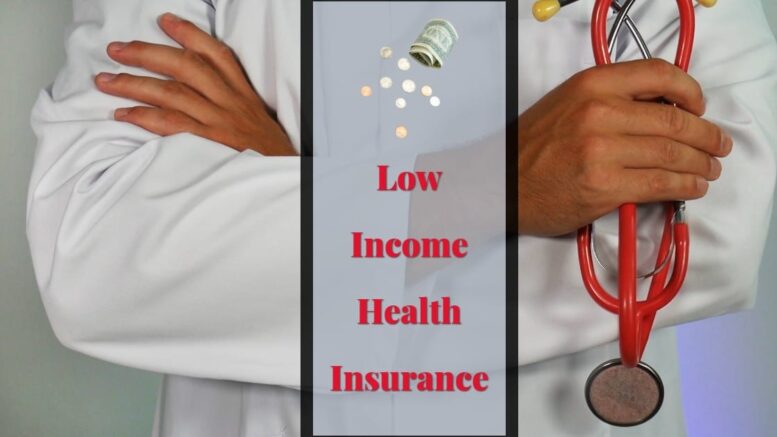Low Income Health Insurance – Overview
Generally, Americans can get health insurance coverage from the government, workplaces, universities, or private health insurance providers.
For low-income earners, most of these options are not always available. To find the best low-income health insurance, it is important to first learn of the available options.
For healthcare to be termed as free or low-cost, it is because:
- The monthly premiums are subsidized to serve low-income Americans
- The benefits you get are reduced, meaning the insurance coverage you get is not comprehensive.
Medicaid – Low-income healthcare coverage option in America
This healthcare program delivers comprehensive government-based healthcare insurance to low-income Americans.
It can be termed as a free social welfare program for anyone who qualifies for it. In most cases, you do not need to pay any monthly premiums to access healthcare through the program.
There is also usually required zero to minimal cost-sharing in terms of copayments and deductibles.
The Medicaid program is paid for by state and federal taxes while controlled at the state level. Even though it is a government-subsidized program, most medical care services are delivered by private businesses.
This means that anyone covered under Medicaid can receive the same healthcare as someone with private health insurance.
Medicaid covers a variety of healthcare-related needs, though the benefits can vary depending on the state. Generally, Medicaid in all states comes with benefits such as:
- Doctor visits
- Inpatient hospital care
- Lab work and X-ray services
- Rural health clinic services
- Counseling for pregnant women
- Certified pediatric and family nurse practitioner services
- Family planning services
The main criteria used to determine whether one qualified for Medicaid is income level. Qualified applicants have an income that falls below the federal poverty level and possesses limited assets.
Remember that the eligibility criteria change based on the category you apply under and the set requirements. For instance, expectant mothers’ eligibility requirements are not the same as those for a disabled individuals.
How to apply for Medicaid
You can learn whether you qualify for Medicaid by applying for one of two ways:
- Through the federal health insurance marketplace
- Through the Medicaid offices in your locality
Once you have submitted your applications, it can take a few weeks for the applications to be processed. You can ensure your application process runs smoothly by ensuring you correctly fill in your application, and provide all required paperwork with your application.
Failure to submit a complete application form can cause your application to take longer to get approved. Eligibility to Medicaid is reviewed on an annual basis.
What happens when Medicaid is denied?
If a Medicaid application is denied, the applicant receives a letter with the explanations for the denial, after which applicants are allowed to appeal the decision.
Reasons for denial can be errors in the application paperwork, among other reasons.
If your eligibility was denied based on your income status, you can always apply again if your income status changes.
Low-income health insurance alternatives to Medicaid
Affordable care act subsidy
Through the affordable care act, the government subsidizes health insurance costs to make it affordable to modest income earners in America.
The subsidies also make it possible for low-income earners to afford and use healthcare insurance.
These subsidies are generally meant to make it possible for low earners to afford private health cover, usually a low percentage of the population.
If you earn an income between 100% and 400% of the poverty level, you qualify for a premium tax credit subsidy where the government pays part of your health insurance premiums each month.
This subsidy program is common among low-income and mid-income earners in America. According to statistics, by 2021, the cost of health coverage for a family of 4 in the 400% poverty level will be equal to an annual income of 104 800.
Individuals in the 100% to 250% poverty level get help from the government when paying insurance premiums, deductibles, copayments, and coinsurance under the cost-sharing reduction subsidy.
These subsidies are only available under Obamacare, available on the Affordable Care Act’s health insurance exchange.
You cannot use these subsidies to pay for health insurance offered in your workplace or any other plan purchase outside the insurance exchange.
Obamacare is also not available to undocumented immigrants, while legally residing immigrants are eligible.
Employment healthcare insurance
Many employers in the USA offer subsidized healthcare insurance to employees and their immediate families as part of the job benefit and compensation package.
This type of affordable healthcare is common in permanent, full-time jobs in large companies and uncommon in part-time jobs and small businesses.
With employer-based healthcare coverage, you are responsible for paying deductibles, coinsurance, and copays.
Employers offer savings plans like health saving accounts, health reimbursement arrangements, and flexible spending accounts for these extra medical expenses.
